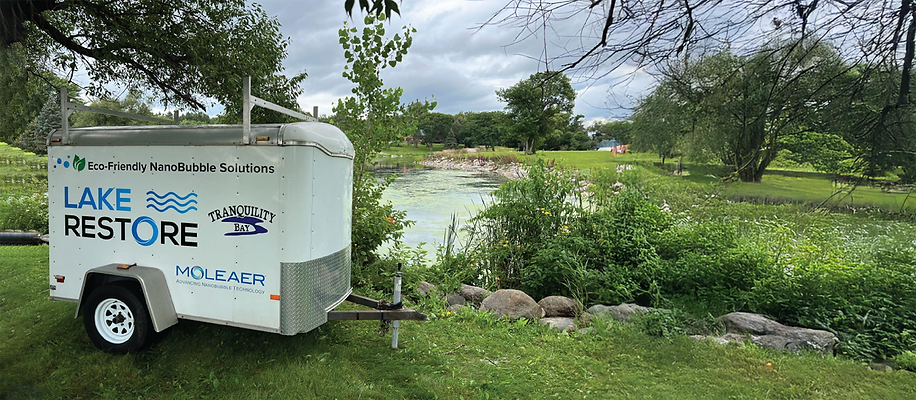Algae Control with Nanobubble Technology
- Chad Woolson
- Feb 21, 2024
- 7 min read
Updated: Feb 26, 2024
Introduction
Nanobubble technology operates on the principle of injecting trillions of tiny, oxygen-rich bubbles into water, providing a sustainable method to combat algae without harming the ecosystem. These systems work by increasing dissolved oxygen levels, thereby enhancing the natural processes that maintain water clarity and health. By doing so, they create an environment that supports beneficial aquatic life while inhibiting the conditions that allow algae blooms to thrive. As a testament to their effectiveness, Molear and Lake Restore's nanobubble generators have been implemented in various settings, demonstrating significant improvements in water quality and offering a glimpse into the future of environmental stewardship.
How NanoBubble Technology Combats Algae
Nanobubbles, being 2500 times smaller than a grain of sand, have a vast surface area relative to their volume, which facilitates a high rate of gas exchange between the bubble and the surrounding water. This exchange significantly increases the dissolved oxygen levels in the water, creating an ideal environment for aerobic bacteria. These bacteria play a pivotal role in maintaining a balanced aquatic ecosystem by breaking down organic matter, including dead algae and plant material, as well as excess nutrients like nitrogen and phosphorus, which are often the primary culprits behind algae blooms. By digesting these nutrients, aerobic bacteria starve algae of the food sources necessary for their growth, thereby preventing their uncontrolled proliferation.
Oxidative Stress and Algae Growth Inhibition
The oxidative properties of nanobubbles introduce an additional, direct mechanism for combating algae. When oxygen-rich nanobubbles come into contact with algae cells, they can induce oxidative stress, weakening or damaging the cell walls. This stress inhibits the algae's ability to perform photosynthesis effectively, disrupts its reproductive cycle, and can lead to the algae's death. This direct intervention targets algae at the cellular level, further reducing the likelihood of bloom formation.
Sustainable and Chemical-Free Algae Management
One of the most significant advantages of nanobubble technology is its environmental sustainability. Traditional methods of algae control often rely on chemical treatments, which can have detrimental effects on non-target species, including fish, plants, and beneficial microorganisms. Chemical treatments can also lead to the development of resistant algae strains, making future control efforts more difficult. In contrast, nanobubble technology provides a chemical-free approach, avoiding these ecological pitfalls and ensuring the health and safety of the aquatic environment and its inhabitants.
Long-Term Ecosystem Health and Water Clarity
Beyond immediate algae control, nanobubble technology contributes to the long-term health and clarity of aquatic ecosystems. By supporting aerobic bacteria and directly targeting algae, nanobubbles help to establish a self-sustaining cycle of nutrient breakdown and oxygenation. This cycle promotes a balanced ecosystem where clear water, healthy fish populations, and thriving aquatic plants can coexist. Moreover, the increased oxygen levels and reduced organic sediment contribute to better water quality, making aquatic environments more resilient to environmental stressors and less susceptible to future algae outbreaks.
Benefits Beyond Algae Control
The benefits of using nanobubble generators extend beyond algae control. These systems increase dissolved oxygen levels, reducing odors and controlling midge flies. They also play a significant role in digesting muck, further improving water clarity and quality. The before-and-after evidence provided by Lake Restore showcases the dramatic improvements nanobubble technology can achieve in water bodies.
Enhanced Dissolved Oxygen Levels
The core function of nanobubble generators—increasing dissolved oxygen levels in water—serves as the foundation for their wide-ranging benefits. Elevated oxygen levels are crucial for supporting aquatic life, from fish to beneficial microorganisms. Oxygen-rich environments promote healthier, more vibrant ecosystems by enabling aerobic processes that break down pollutants and organic waste. This increased oxygenation also helps to stabilize the water's pH levels, further contributing to the overall health of the aquatic ecosystem.
Odor Reduction and Midge Fly Control
Odorous compounds in water bodies, often a result of anaerobic decomposition, can create unpleasant conditions for nearby residents and wildlife. Nanobubble technology combats these odors by enhancing aerobic decomposition, which is less likely to produce malodorous gases. The same principle applies to controlling midge flies, pests that breed in water with high levels of organic decay. By reducing the organic muck and increasing oxygen levels, nanobubble systems disrupt the breeding grounds for these insects, significantly reducing their populations and the nuisance they pose.
Digestion of Organic Muck
Organic muck—the accumulation of dead plants, leaves, and fish waste on the bottom of ponds and lakes—can be a significant challenge in water management. Nanobubble generators address this issue directly by accelerating the breakdown of organic matter. The process not only improves water clarity and quality but also restores depth to silted-in water bodies. Reducing the layer of muck on the bottom also diminishes nutrient reserves that could fuel future algae blooms, thereby contributing to a more balanced nutrient cycle in the water body.

Evidence of Dramatic Improvements
The effectiveness of nanobubble technology is not just theoretical; it's supported by tangible, observable outcomes. Lake Restore's/Molear's documentation of before-and-after scenarios illustrates the profound impact that nanobubble generators can have on water clarity, quality, and overall ecosystem health. These transformations are evident in the reduced algae presence, clearer water, diminished odors, and healthier aquatic life. Such evidence reinforces the value of nanobubble systems as a comprehensive solution for water body management.
Broader Ecological Impact
Beyond the immediate environment of a treated water body, nanobubble technology has broader ecological implications. By maintaining cleaner, healthier water bodies, these systems support biodiversity, offering a refuge for various aquatic species. Furthermore, the chemical-free approach of nanobubbles aligns with sustainable management practices, protecting water resources for future generations. The role of nanobubbles in enhancing water quality also contributes to the recreational and aesthetic value of lakes and ponds, making them more enjoyable for communities and more hospitable for wildlife.
NanoBubble Technology
The range of nanobubble generators offered by Lake Restore and Molear is designed to address the specific needs of various water bodies, from small decorative ponds to large lakes or reservoirs. Each model in their lineup stands out due to its unique features and capabilities, making them suited for different applications and challenges in water treatment.
Kingfisher
The Kingfisher model is distinguished by its compact size and efficiency, making it an ideal choice for smaller applications. It boasts a flow rate of 40 gallons per minute, perfect for small ponds, residential lakefronts, or golf course water features. Its lightweight design, at just 55 pounds, allows for easy installation and mobility, ensuring that even the most secluded or difficult-to-reach water bodies can benefit from its algae-fighting capabilities. The Kingfisher's effectiveness in smaller settings does not compromise its performance; it delivers a concentrated dose of oxygen-rich nanobubbles, fostering a healthy aquatic environment by enhancing water clarity and supporting beneficial microbial life.
Clear 150
The Clear 150 steps up as the solution for larger water bodies, offering a robust flow rate of 150 gallons per minute. This model is tailored for large ponds, bays, and small irrigation reservoirs that require significant water quality improvements. Its heavy-duty design is capable of handling larger volumes of water, making it an ideal choice for community ponds, larger residential areas, or agricultural sites. The Clear 150 also features optional remote equipment and water quality monitoring, enabling precise control and optimization of water treatment processes, ensuring maximum efficiency and effectiveness in improving water clarity and health.
NEO
The NEO represents the pinnacle of customization in nanobubble technology. Equipped with an oxygen concentrator, the NEO can generate nanobubbles consisting of 93% oxygen, offering superior treatment capabilities for lakes and ponds with specific needs. This model is particularly beneficial for water bodies with unique ecological characteristics or those requiring targeted intervention to address complex water quality issues. The NEO's adaptability allows for tailored solutions that can enhance dissolved oxygen levels, combat algae growth, and support the overall ecosystem's health more effectively than one-size-fits-all approaches.
Titan
For the most demanding applications, the Titan model offers unparalleled capacity, capable of treating up to 5,000 gallons of water per minute. This industrial-scale solution is designed for very large water bodies or those requiring rapid, extensive treatment. The Titan's customizable and scalable features allow it to be built inside a mobile trailer, offering flexibility in deployment and the ability to achieve fast results over large areas. It's perfect for municipal water treatment projects, large-scale agricultural irrigation systems, or any scenario where vast volumes of water need to be purified quickly and efficiently.
Economic and Operational Advantages
The adoption of nanobubble technology not only promotes ecological balance and water quality but also presents significant economic and operational advantages for water body management. These benefits are crucial for municipalities, private property owners, and environmental organizations considering the long-term sustainability and cost-effectiveness of their water treatment strategies.
Cost Efficiency
Nanobubble generators, despite the initial investment, offer substantial cost savings over time compared to traditional chemical treatments. The reduction in chemical usage not only lowers direct expenses but also mitigates the risk of chemical overuse and the potential need for remediation of chemical residues, which can be costly. Furthermore, the energy-efficient operation of nanobubble systems minimizes electricity consumption, contributing to lower ongoing operational costs. These economic benefits make nanobubble technology a financially viable solution for long-term water quality management.
Low Maintenance Requirements
The design and engineering of nanobubble generators prioritize durability and ease of maintenance, essential factors for operational efficiency. These systems typically require minimal maintenance, reducing the labor and costs associated with routine upkeep. The reliability and longevity of nanobubble equipment ensure continuous, uninterrupted water treatment, providing a hassle-free solution for managers and caretakers of water bodies.
Enhancing Property Value and Recreation
The improvements in water quality and clarity resulting from nanobubble technology directly enhance the aesthetic appeal and recreational value of lakes, ponds, and reservoirs. For residential property owners, this can translate into increased property values and enhanced enjoyment of their waterfront assets. For public spaces, cleaner and healthier water bodies attract more visitors, potentially increasing tourism and local business revenue. The ability to provide safe, attractive, and recreational water environments is a significant advantage of incorporating nanobubble systems into water management practices.
Conclusion
In conclusion, the advent of nanobubble technology marks a transformative era in water treatment and environmental management. As we've explored throughout this blog, the unique properties of nanobubbles—such as their ability to remain in suspension for extended periods, provide sustained oxygenation, and effectively combat algae growth—underscore their potential to revolutionize how we approach the health of aquatic ecosystems.
Beyond algae control, the benefits of nanobubble technology extend to odor reduction, muck digestion, and the overall enhancement of water clarity and quality, demonstrating their versatility and efficiency.
For industries, municipalities, and environmental stewards alike, adopting nanobubble technology represents not just an investment in superior water treatment solutions, but also a commitment to sustainability and ecological balance. The evidence is clear: through increased dissolved oxygen levels, innovative treatment of pollutants, and a chemical-free approach, nanobubble technology offers a promising pathway to cleaner, healthier water bodies across the globe.
As we continue to face the challenges of water pollution and ecosystem degradation, the role of advanced solutions like nanobubble technology becomes ever more critical.
By embracing these innovations, we can ensure the vitality of our water resources for future generations, supporting biodiversity, recreational activities, and the well-being of our communities. The journey towards sustainable water management is complex, but with nanobubble technology, we are equipped with a powerful tool to navigate these waters successfully, heralding a new wave of environmental stewardship and technological advancement.
Learn more about nanbubble technology check out Lake Restore's case studies here.













Σχόλια